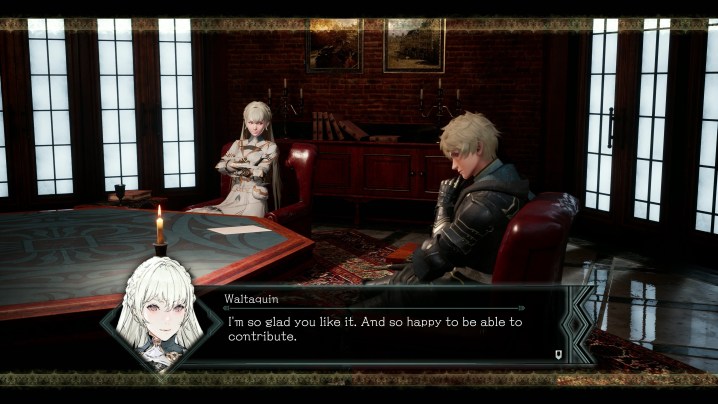The DioField Chronicle, a new IP developed by Lancarse and published by Square Enix, is the latest in a growing trend of tactical RPG games. While plenty of those kinds of games have come out this year already (including Triangle Strategy, Relayer, and Digimon Survive). The DioField Chronicle intends to put its own spin on the genre and stand out in a crowded field.
To get a sense of how The DioField Chronicle is setting itself apart, I spoke to Lancarse development director and battle designer Fukui Hirofumi, Square Enix producer Shigeyuki Hirata, and art director Kumagai Takahiro. The team members discussed The DioField Chronicle’s gameplay influences, art direction, and how they created a newcomer-friendly strategy game in a daunting genre.
But it was me, Dio(Field)!
The DioField Chronicle was first revealed during PlayStation’s State of Play presentation in March. When the game’s reveal trailer premiered, viewers thought it could be a new Final Fantasy Tactics game. Then, at the end of the trailer, the game’s title card appeared, showing that it was instead a new IP entirely.
Hirata says it was a surprise that the audience perceived the game as a potential new Final Fantasy Tactics game. The team is aware that the game is a one-of-a-kind masterpiece, and that The DioField Chronicle would inevitably be compared to some of its predecessors in the strategy RPG genre. However, Final Fantasy Tactics wasn’t actually as big of an influence on The DioField Chronicle.
“We weren’t directly conscious of the title when developing the game,” Hirata tells Digital Trends. The DioField Chronicle has shades of real-time strategy (RTS) game influences, but its gameplay was actually more inspired by MOBA titles such as League of Legends. MOBA games (like Overwatch) typically offer a range of different characters with their own special abilities for players to control and are more team-based. This fits in with the fact that The DioField Chronicle has a limit of four characters being able to be deployed during battle.
In comparison, RTS games like Starcraft and Halo Wars involve managing an economy and sending waves of faceless units to their deaths. MOBA games served as larger inspirations for The DioField Chronicle because the development team was considering ways to incorporate more compact missions within a strategy RPG framework.
“With regards to the top-down field of view, perhaps Diablo served as more of an inspiration in that respect,” says Hirofumi. “Because we were building out an SRPG with real-time elements, those two served as more inspiration.”
Approaching the strategy genre
Lancarse has created several other strategy RPG games in the past, such as Monark and Lost Dimension, the latter of which Hirofumi worked on as a battle designer. He felt like there was a lack of approachability and replay value in recent titles in the genre and wanted to address that in The DioField Chronicle.
We are hoping that it will become one of the standards for SRPGs.
Have you ever played a game where you failed a mission, and thought to yourself, “Wait, how did I lose?” Hirofumi says he believes that there’s a discrepancy between what the game considers “game over” and what the player believes as such.
“When factoring in real-time elements with this game, I felt that when players make a mistake, there may be a broad feeling towards this,” he continues. “Taking that, in order to increase playability with this game, we inserted checkpoints in between missions where there were good breaks.”
This allows players to head back to checkpoints during gameplay when they encounter the game over message so that they can figure out what exactly went wrong in their approach, what mistakes they made in their tactics, and then replay it again to figure out what works.

Hirofumi explains: “We tried to increase the replayability of the game in such a way so that players can become better at the game quickly, or it’ll be easier for players to find their very own tactical strategy, and so forth.”
The DioField Chronicle has plenty of visual flair when it comes to the characters’ special attacking skills. However, it isn’t just for show. “We wanted to ensure that what you were doing was clearly communicated through the visual presentation,” explains Takahiro. “And so it wasn’t just for flair, per se, but ensuring that those strategic elements and strategic actions that you’re taking are clearly expressed through visual means as well.”
Setting a new standard
The DioField Chronicle’s development was handled mostly by Lancarse. As for the art direction, including the 2D illustrations and cutscenes, Square Enix worked closely with Lancarse They also collaborated with other companies for hefty assets such as 3D models and motion capture.
Since The DioField Chronicle is a new IP, Hirata hopes that he can continue expanding on its world even further and that it will be received well so the team could have the opportunity to do so.

“We are hoping that it will become one of the standards for SRPGs. Since this is our first title, we believe that there is still room for deepening the mechanics and lore, so we would like to continue along this path,” he explains. “As for the audience reactions, we would of course like for them to find it fun and interesting, but at the same time, we would like their honest feedback on changes that they would like to see since it is our first title.”
The DioField Chronicle launches on September 22 for PC, PlayStation 4, PlayStation 5, Nintendo Switch, Xbox One, and Xbox Series X|S. A demo is available now on all platforms.



